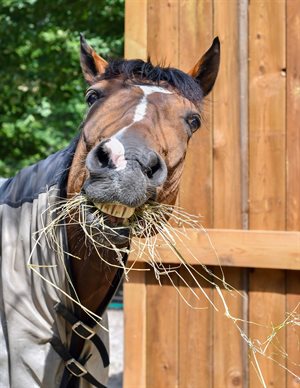|
This article first appeared in a previous edition of Equestrian Life magazine. To see what is in our latest digital issue, please click here.

By David Nash
When feeding the performance horse, you first need to understand that your horse is an individual, as we established in the previous article. Here, in Feeding the Performance Horse Part 2, we learn how to tailor a diet just right for that individual.
In my previous article, we learnt the importance of making sure you get to know your horse. We learnt that we need to know its weight, height and metabolism, and we touched on energy requirements and workload as well as assessing what you have available as inherent feed supply, such as pasture.
In this article, we will work through our nutrient requirements for performance horses from pony club weekend warriors to FEI Grand Prix horses. We will also discuss the different sources of nutrients and how their combinations contribute to a horse’s diet. Having recognised your horse as an individual, you can then assess its workload, condition targets and competition demands when formulating its diet. We can then select the nutrients with which we will formulate an individual horse’s diet. The key nutrients we will discuss are water, carbohydrates, fats, fibre, minerals and vitamins.
Water
Water is the key and most limiting nutrient. Like us, horses are made up of over 70 per cent water. Horses will die of dehydration before they will die of starvation. An average 500kg horse requires 20-30L per day in nil to light work, in moderate weather conditions. However, this can increase to 70-80L per day in hot or humid conditions and intense workloads. It is important to note that horses suffering from slight dehydration will have altered electrolyte balances that can affect their ability to perform, react and recover. We will discuss this later with regards to electrolyte supplementation.
Fibre
Fibre is the most important energy source for performance horses. Remember, a horse’s digestive system has evolved around digesting fibre as its main source of energy. Whilst fibre is present in most ingredients we feed our horses, our high-fibre ingredients are our pastures, hay and some novel ingredients such as legume hulls and beet pulp. The nutrient fibre consists of several forms that are digestible to the horse in various capacities. The main ones we will see are cellulose, hemicellulose and lignin, and some not so common ones such as Pectin. A very basic approach is that cellulose and hemicellulose are broken down by the horse in the large intestine to volatile fatty acids, which are then eventually converted in the body’s cells to energy. Lignin is totally indigestible to the horse. An example is that a lush ryegrass pasture will be high in digestible fibres and will be soft to your touch. Lignin is a structural fibre so will be hard or sharp when you grab it. An example of this is straw. As a result, a quick and simple quality check will be a “grab” sample. If the fibre source is soft it is potentially well digestible; if it is hard it will be poorly digested.
A main proportion of a performance horse’s diet can be derived from fibre-based products. This may range from 1.5-2.5 per cent of the horse’s bodyweight per day. This amount will vary depending upon horse, workload and metabolism. For most of our horses for dressage, show jumping and showing, a higher proportion of the diet should be fibre based with additional energy coming from fats and carbohydrates.
Fats
Fats as a nutrient source have become more evident in equine diets over the last decade or so. Fats play many important roles in some metabolic pathways. As a nutrient, we have focussed on fat as an energy source for horses. Horses digest vegetable-based fats quite efficiently. Fats are very high in energy. For example, vegetable oil may have 36-38 MJ/kg of energy, oats may have 12Mj/kg of energy and average pasture hay may have 8MJ/Kg of energy. For performance horses fats are a good source of “calm” energy, as they do not produce an insulin response like carbohydrates (grains) do. This will reduce the sugar rush that can affect the performance of horses that are on high-grain (carbohydrate) diets. If you are looking to reduce your grain intake on your performance horse, a rule of thumb would be 300ml of vegetable oil can replace 1kg of grain. Remember, if the grain portion of your horse’s diet is a commercially formulated feed, changing the amount you feed may affect the nutrient ratios in your horse’s total diet and the effectiveness of the diet. Consult your nutritionist to ensure your diet changes are still meeting all nutrient requirements.
Omega essential fatty acid levels in fats have caused much discussion in equine diets. Most of us will have heard of omega 3, 6 and 9. These occur in various ratios in our feed ingredients. Cereal grains are naturally high in omega 6 whereas canola and flax lean more towards omega 3. It is thought that a diet with a higher proportion of omega 3 in it will assist with reducing the pro-inflammation effects of prostroglandin in a horse’s joints.
Carbohydrates
Carbohydrates are often seen as the enemy in human nutrition and also in equine nutrition. They do not necessarily need to be banished from our diets. Cereal grains such as oats, barley and corn are high in carbohydrates, and while not as energy-dense as fat, are a lot higher in energy than poorer quality pastures. For performance horses, the overfeeding of carbohydrates/grains can result in not only an overload of the digestive tract leading to health problems such as acidosis and laminitis, but also poor performances and, if unchecked, metabolic disorders such as obesity of EMS (equine metabolic syndrome). Management of feeding carbohydrates is the key to optimum performance. Feed small amounts frequently. This gives the horse’s digestive tract enough time to digest the feed and reduce negative impacts associated with overloading it. I would suggest feeding no more than 2kg of grain per feed. Use processed grains such as steam-flaked and micronized. These grains are more readily available to the horse so they are digested more in the small intestine, thus reducing the risk of overloading the large intestine where the fibre portion of the diet is digested.
Many lower-intensity exercised horses may not need grain/carbohydrates added to their diets, they may be able to meet their nutrient requirements from pasture/hay and a small amount of supplementary feeding such as a vitamin and mineral supplements and salt. As the work intensity increases, such as FEI standard dressage, show jumping and eventing, supplementation for energy etc will be required as generally pasture will not be able to provide sufficient nutrients to enable a horse to perform or, just as importantly, recover from exercise.
Protein
Protein is frequently confused for energy. Proteins are often referred to as the building blocks of the body. They are involved in many metabolic pathways in the body as well as contributing to growth, development and repair of muscle cells and organs. Proteins are made up of amino acids. These are then broken up into essential and non-essential amino acids. A horse can generate non-essential amino acids, however, essential amino acids must be provided in the horse’s diet as you can derive a higher quality protein ingredient. In equine diets the main two amino acids we will look for are lysine and methionine. Nutritionists will refer to these as “limiting amino acids”. These will be the most used amino acids for producing different proteins for the body. If we do not have enough of these limiting amino acids, the horse will not be able to make the desired protein. Soybean meal and canola meal are high in essential amino acids, whereas products like copra are lower in essential amino acids. Another benefit from feeding quality amino acids is that the body will deposit this as muscle or “topline’’. Poorer quality protein sources will not be able to generate as much muscle and will eventually deposit more fat as a result. For performance horses, we are looking for muscular horses to perform their manoeuvres at an optimum level
Horses in growth and development stages, such as young horses or lactating mares, will require higher protein diets (14-16% of total diet). Mature horses, whether idle or on light work, will require a lower protein diets (10%). Performance horses that are performing at high levels will need an increased level of high-quality protein to assist in the recovery of muscles from previous performances.
These core nutrients are the basis of any equine diets. In my next article we will review minerals and vitamins and how they play an important part in the performance horse’s diet and then we will look at specific diets for various different performance horses from Grand Prix dressage horses and four-star eventers to a Level 4 HRCAV horse.
READ THE LATEST NEWS ARTICLES HERE

|

